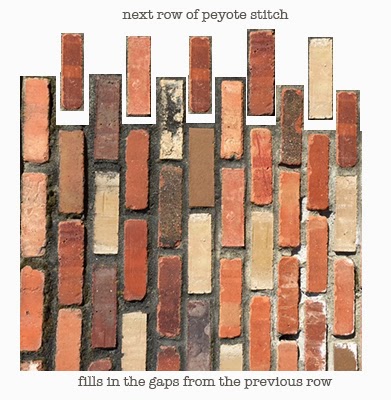To understand freeform beadweaving, you first need to have a strong understanding of the regular version of the stitch.
- Peyote Stitch reminds me of bricks in a wall; each row is offset a half-step from its immediate neighbors. (Above Left)
- Turn the brick wall on its side, and the similarity is even more pronounced. (Above Right)
- With the wall on its side, the gaps at the top show you where you need to place the bricks (or beads) to build the next row of peyote stitch.
This assumes you are working with materials (bricks or beads) of roughly the same size.
What happens if your bricks or beads come in a bunch of different sizes? This is where Freeform Peyote comes in!
Don't throw out the whole concept of peyote stitch. You will still be working with rows offset by a half step from neighboring rows to either side.
- Like the photos of the stone and brick wall above, you will still have very recognizable sections of peyote stitch.
- The key is marrying the sections.
- It can help to organize your beads by size - I find freeform peyote is easier when I group like with like.
- Build discrete sections with the different sizes of beads, don't just mix them willy-nilly.
- Freeform is not random. It is a more organic melding of different sizes and shapes.
This example of freeform peyote doesn't have the extreme size variances of the stone and brick wall, but you can see how I've grouped sections of similarly sized beads together. My larger accent and focal beads are surrounded and supported by peyote stitch.
Last tips
- Don't try (or expect) to do everything at once!
- Just like building a wall, you will work one row at a time.
- With each row, you have the opportunity to make decisions regarding bead sizes, shapes (and colors).






Great post, peyote making sense!
ReplyDeletejust seeing this post Karen ... what a great way to explain the freeform concept!
ReplyDeletejust seeing this post Karen ... what a great way to explain the freeform concept!
ReplyDelete